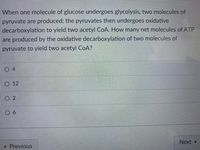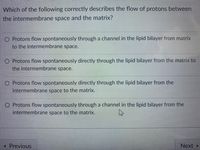
Chemistry
10th Edition
ISBN: 9781305957404
Author: Steven S. Zumdahl, Susan A. Zumdahl, Donald J. DeCoste
Publisher: Cengage Learning
expand_more
expand_more
format_list_bulleted
Concept explainers
Question

Transcribed Image Text:When one molecule of glucose undergoes glycolysis, two molecules of
pyruvate are produced; the pyruvates then undergoes oxidative
decarboxylation to yield two acetyl CoA. How many net molecules of ATP
are produced by the oxidative decarboxylation of two molecules of
pyruvate to yield two acetyl COA?
O 12
Next
« Previous

Transcribed Image Text:Which of the following correctly describes the flow of protons between
the intermembrane space and the matrix?
O Protons flow spontaneously through a channel in the lipid bilayer from matrix
to the intermembrane space.
O Protons flow spontaneously directly through the lipid bilayer from the matrix to
the intermembrane space.
O Protons flow spontaneously directly through the lipid bilayer from the
intermembrane space to the matrix.
O Protons flow spontaneously through a channel in the lipid bilayer from the
intermembrane space to the matrix.
« Previous
Next
Expert Solution
This question has been solved!
Explore an expertly crafted, step-by-step solution for a thorough understanding of key concepts.
Step by stepSolved in 3 steps

Knowledge Booster
Learn more about
Need a deep-dive on the concept behind this application? Look no further. Learn more about this topic, chemistry and related others by exploring similar questions and additional content below.Similar questions
- Consider the following reaction: (P, is inorganic phosphate, i.e., HPO4² and H₂PO4) glucose + P + 3.3 kcal glucose-6-phosphate + H₂O If the energy used for the reaction is obtained from the hydrolysis of ATP (AH = -7.3 kcal.mol), the reaction will go to completion. Select one: O True O Falsearrow_forwardUnder what circumstances and where are ketone bodies made? What is the purpose of ketone body formation and where are they utilized?arrow_forward1. What is the classification of the reaction shown? NADH + H+ NAD+ CH3-C-C-0- pyruvate OH O | 11 CH3-C-C-0- H lactate A) oxidation B) reduction C) hydration D) phosphorylationarrow_forward
- The stage in glucose catabolism in which carbon dioxide is generated is: O Glycolysis O Bridging step/TCA cycle Light dependent reactions O Light independent reactionsarrow_forwardPlease don't provide handwriting solutionarrow_forwardWhich of the following functional groups is the most stable to metabolism? a. O b. O c. O d. HO HN upra Me All functional groups are metabolised at the same rate.arrow_forward
- What glycolytic intermediate is glycerol, formed by hydrolysis of triacylglycerols, first converted to during its metabolism? A) glucose Question 18 of 20 B) dihydroxyacetone phosphate C) glycerol 3-phosphate D) ATP E) glycinearrow_forwardWhich statement is TRUE regarding ketone bodies? O Ketone bodies are only formed during times of starvation. Excess acetoacetate produced during ketone body production is mostly exhaled. O Ketone bodies can easily travel from one tissue to another in the body due to the preser Coenzyme A. O Ketone bodies tend to be formed when oxaloacetate concentrations are high. O Ketone bodies can be used as a source of acetyl-CoA in target tissues when blood glucosarrow_forward
arrow_back_ios
arrow_forward_ios
Recommended textbooks for you
 ChemistryChemistryISBN:9781305957404Author:Steven S. Zumdahl, Susan A. Zumdahl, Donald J. DeCostePublisher:Cengage Learning
ChemistryChemistryISBN:9781305957404Author:Steven S. Zumdahl, Susan A. Zumdahl, Donald J. DeCostePublisher:Cengage Learning ChemistryChemistryISBN:9781259911156Author:Raymond Chang Dr., Jason Overby ProfessorPublisher:McGraw-Hill Education
ChemistryChemistryISBN:9781259911156Author:Raymond Chang Dr., Jason Overby ProfessorPublisher:McGraw-Hill Education Principles of Instrumental AnalysisChemistryISBN:9781305577213Author:Douglas A. Skoog, F. James Holler, Stanley R. CrouchPublisher:Cengage Learning
Principles of Instrumental AnalysisChemistryISBN:9781305577213Author:Douglas A. Skoog, F. James Holler, Stanley R. CrouchPublisher:Cengage Learning Organic ChemistryChemistryISBN:9780078021558Author:Janice Gorzynski Smith Dr.Publisher:McGraw-Hill Education
Organic ChemistryChemistryISBN:9780078021558Author:Janice Gorzynski Smith Dr.Publisher:McGraw-Hill Education Chemistry: Principles and ReactionsChemistryISBN:9781305079373Author:William L. Masterton, Cecile N. HurleyPublisher:Cengage Learning
Chemistry: Principles and ReactionsChemistryISBN:9781305079373Author:William L. Masterton, Cecile N. HurleyPublisher:Cengage Learning Elementary Principles of Chemical Processes, Bind...ChemistryISBN:9781118431221Author:Richard M. Felder, Ronald W. Rousseau, Lisa G. BullardPublisher:WILEY
Elementary Principles of Chemical Processes, Bind...ChemistryISBN:9781118431221Author:Richard M. Felder, Ronald W. Rousseau, Lisa G. BullardPublisher:WILEY

Chemistry
Chemistry
ISBN:9781305957404
Author:Steven S. Zumdahl, Susan A. Zumdahl, Donald J. DeCoste
Publisher:Cengage Learning

Chemistry
Chemistry
ISBN:9781259911156
Author:Raymond Chang Dr., Jason Overby Professor
Publisher:McGraw-Hill Education

Principles of Instrumental Analysis
Chemistry
ISBN:9781305577213
Author:Douglas A. Skoog, F. James Holler, Stanley R. Crouch
Publisher:Cengage Learning

Organic Chemistry
Chemistry
ISBN:9780078021558
Author:Janice Gorzynski Smith Dr.
Publisher:McGraw-Hill Education

Chemistry: Principles and Reactions
Chemistry
ISBN:9781305079373
Author:William L. Masterton, Cecile N. Hurley
Publisher:Cengage Learning

Elementary Principles of Chemical Processes, Bind...
Chemistry
ISBN:9781118431221
Author:Richard M. Felder, Ronald W. Rousseau, Lisa G. Bullard
Publisher:WILEY